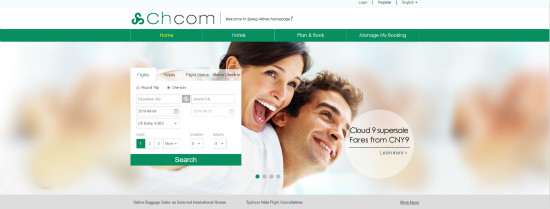ChinaTravelNews, Ritesh Gupta - Airlines today are gearing up to embrace retailing, a trend that indicates that the focus is not just on selling only air tickets or air and non-air ancillary offerings.
As Ryanair asserts, the European carrier’s objective is to become the platform of choice for all travel needs, not just flights.
Broadly speaking, it’s just not Ryanair there are others, too, that aspire to emulate the same.
Chinese carrier Spring Airlines is working on a series of initiatives to shape up such transformation as well.
Acknowledging the fact that the industry isn’t only looking at facilitating a purchase, Spring’s Social Marketing Director Jonathan Hutt mentioned that there is a need to be a part of travellers’ entire journey. “There needs to be a constant dialogue between the traveller and the travel service provider. Also, (what we have to offer) it shouldn’t be seen as only an aviation product, rather it’s about working on one-stop travel shop environment,” he said.
And as things are progressing, what airlines are now looking at are “platforms” and just not a website.
Embracing change
Of course, when we talk of what any online retailing platform needs, it’s a huge undertaking for any airline. Be it for working on the requisite infrastructure, running data-driven merchandising, embracing core shopping cart and check-out functionality across multiple devices etc., a lot needs to be done. “It’s a major investment decision,” says Hutt, who added that the platforms of today deliver in terms of usability, personalisation and ensure payment options are effective.
Other than incurring expenditure, airlines also need to ensure various teams and optimize existing resources.
For instance, Spring is contemplating how to make the most of what the carrier (ch.com) has to offer and blending it with www.springtour.com. One of the initiatives in the pipeline is to integrate two assets, and do away with different domains. “This is still in the planning stage. Both sides need to understand expectations, there would be multiple iterations, and product managers and senior management need to jointly decide on the future,” explained Hutt.
It also needs to be noted that this major transition comes at a time when the carrier is growing.
When we talk of growth – such as addition of 8 aircraft over the past 2 months or addition of 20 new destinations in the coming months – this means that there isn’t any easy way to benchmark the performance of ancillary revenue. “Our KPIs are strong, and being reviewed every quarter,” said Hutt. For the record, if we consider how Spirit Airlines has fared, the US-based carrier’s ancillary revenue accounted for over 43% of their total revenue per passenger, which stood at $119 last year (according to IdeaWorksCompany’s recently released study).
Work in progress
Hutt indicated that there are lots of initiatives in store as far as e-commerce, merchandising and distribution are concerned.
1. New version of website: Spring Airlines is planning to launch a new website soon, first for the Chinese version and this would be followed by the new version for international (English) website, Japanese, Korean etc. “The new site, version 5.0, would be mobile friendly as we don’t have a mobile website yet,” shared Hutt. “As we have noticed, say users from Singapore, access our site from their mobile devices, so it’s imperative to work on such version.” Hutt shared that the new site will stand out for its functionality, design etc. “So, for example, displaying and selling of ancillaries on mobile devices is going to improve with the new version. Selection would be easy for the user,” promised Hutt.

2. New payment options: Talking of international websites, which are available in different versions (one for Hong Kong/ Macau/ Taiwan, plus Korean, Thai, Japanese and global English versions), Hutt mentioned that the decision to introduce WeChat Wallet has paid off since its launch late last year. “We have seen that there are segments like local expat residents who aren’t too keen on using international credit cards online in China or linking their debit card/ Internet banking. This demographic is young and has disposable income. They are open to using WeChat Wallet. In fact, we have been running flash sales (for tickets as low as 1RMB or 9 RMB) and these are working out so we planning more. For example, soon there would be one for Japanese destinations. So we are continuously assessing departure cities and interest for trips, and accordingly work out such promotions. The payment options have to be reliable and diverse, otherwise it can hamper the booking process,” added Hutt. He mentioned that the carrier is planning to integrate Apple Pay and Alipay, too.
3. Being in control: Hutt categorically stated that the carrier is always keen on having a dialogue with customers, even if they are coming via indirect channels. “Yes, we are working with indirect channels, but being in control of cost or letting a customer buy other trip essentials after they have booked via a 3rd party channel is our priority,” said Hutt. Elaborating further, Hutt mentioned that the team already allows non-member log-in on its domestic site even if a customer buys from a 3rd party, whereas the same functionality is yet to be introduced on international websites. But the team is working on this. This way a customer ends up buying whatever is available on airline’s website.
4. Expanding range of ancillary products: Spring Airlines is working with booking.com to accommodation options on its website. Hutt asserted that this arrangement works well considering the core value proposition of pricing for both the airline and its OTA partner. “We already have great deal of content on our domestic Chinese website, but we are looking at adding more of it on our international websites,” shared Hutt. At the same time, Hutt also mentioned that if there are logistic issues with any ancillary offering, the team isn’t going to push for an offering. So if there is a pick-up available at the airport, but if owing to language barrier or any other hurdle a foreigner isn’t able to avail the service then there is no point in offering it. So fulfilment remains a big focus when it comes to expanding ancillary product mix.
5. Testing: Hutt stressed on the fact that any initiative taken will always be under scrutiny. So when I asked him about progressive web apps, he was quick to point out that all depends upon the feedback from the new version. “We are going to monitor, identify where we need to improve. (New website) is a major investment, and it could negatively or positive hamper our sales. Looking at areas like cart abandonment and concrete buying behaviour data, we would understand user experience issues and then take a call from there,” he said.
On a parting note, Hutt did mention that “complexity is enemy” in case of a carrier like Spring and there is no way the airline would live with it. He referred to cutting down on fare classes from 3 to 2 for both domestic and international websites. “We are working on this, as we have realized upselling can be tough as more options means the customer sees things little differently,” said Hutt.
Clearly Spring is attempting to make rapid strides, and on look-out for chartering its own course to excel in the arena of retailing.
Mr. Yu Wang, president of Spring Airlines will attend 2016 China Airline Distribution Conference held by Travel Daily.




